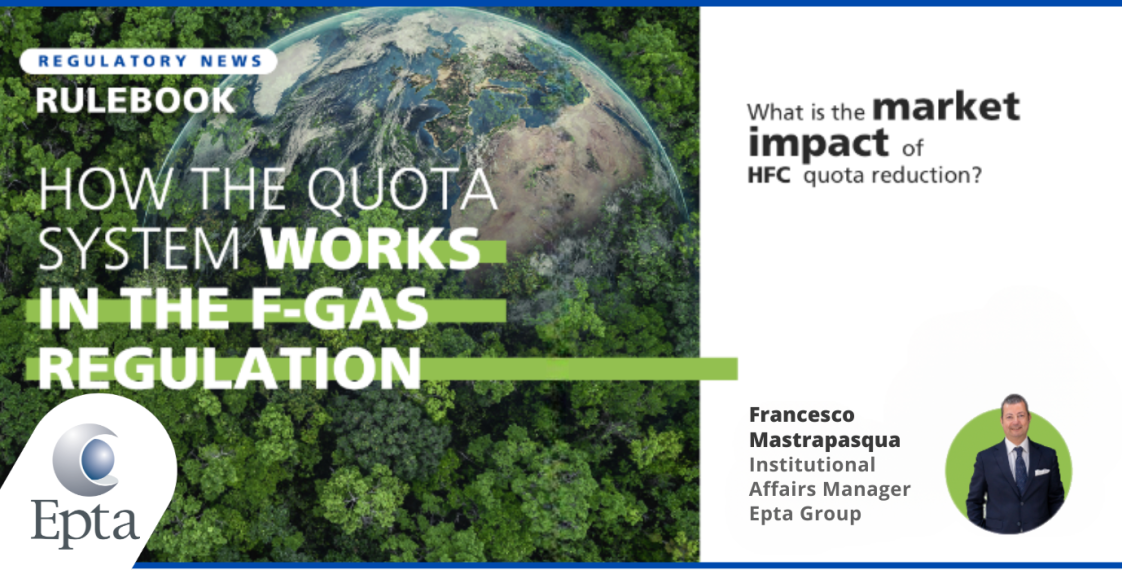THE HFC QUOTA PHASE DOWN AND ITS IMPACT ON THE MARKET

The F-Gas Regulation aims at reducing the emissions of fluorinated greenhouse gases, promoting the use of more environmentally friendly alternatives to F-Gases and capping sales of HFCs on the EU market through an HFC phase-down.
A pillar of this european regulation is the quota system that introduces a steep reduction in the amounts and the global warming potential (GWP) of the refrigerants that producers and importers of HFCs may place on the EU market.
European Regulation 517/2014, in force since May 2014 and until earlier this year, established drastic reductions of greenhouse-effect gases, aiming at a 79% reduction by 2030 (using the average emissions recorded between 2009 and 2012 as reference). At international level, HFC consumption is regulated under the Kigali Amendment to the Montreal Protocol. In accordance with the 2016 amendment, which came into effect in 2019, all countries having ratified the Amendment globally committed to an HFC phase-down of 85% of the baseline although at different dates within 2050. For the EU and the group of developed countries the target due date is 2036.
In response to the European Climate Law, the Kigali Amendment and the need for stronger action, building on the success of its predecessor, the new F-Gas Regulation (EU) 2024/573 was adopted in February 2024, being the first legal act worldwide aiming at the complete elimination of HFCs by 2050. As a matter of fact, not only does the new F-Gas Regulation significantly cut down the HFC quota allowances especially in the upcoming 5 years, but it additionally broadens the scope of products that fall within the quota limits to include the metered dose inhalers (MDI) into the account, thus leaving a very small residual quantity of F-Gases for each sector.
Ensuring the correct following of quota limits and preventing the illegal trade of refrigerants from extra-EU markets was considered a weak point of the previous regulation by many. However, the new F-Gas Regulation introduces more digitalisation and the electronic automation of custom control to allow enhanced enforcement and monitoring in the Member States.
What consequences can we expect on the commercial refrigeration sector in this new situation?
In order to answer this question we must first understand how the quota phase down works. The Carbon dioxide (CO2) equivalent is a metric of how much a gas contributes to global warming, in reference to quantities of carbon dioxide. To calculate the CO2 equivalent of a greenhouse gas, it is necessary to multiply the mass of the gas by its Global Warming Potential (GWP).
The GWP of a gas refers to the total contribution to global warming resulting from the emission of one unit of that gas relative to one unit of the reference gas, CO2, which is assigned a reference value of 1.
The HFC quota is the maximum yearly CO2 equivalent of the total amount of HFCs placed on the market in any given year. To place bulk HFC gases on the market, gas producers and distributors must hold sufficient quotas, which are expressed in tonnes of CO2 equivalents to create an incentive to use gases with a lower global warming potential. The maximum quantities of quotas are set to progressively decrease 3 times in 2027 and 6 times in 2030, compared to the current 2024 value.
Challenges and Strategies in the Quota System for HFCs: Implications for Market Dynamics and Sectoral Adaptation
Since 2017, HFCs in imported refrigeration, air conditioning and heat pump equipment have also been included in the quota system by means of quota authorisations that equipment importers acquire from quota holders.
The quota foreseen in 2030 is just 9 MCO2eqT, which is equivalent to the emissions of the medical sector alone, nevertheless it must be sufficient for all the sectors relying on HFCs, primarily the RACHP sector and the maintenance of the existing systems.
Important efforts have been undertaken and will become increasingly important at EU and Member State levels to reduce HFC leakage from refrigeration and air conditioning equipment, encouraging the recovery of gases at the end of equipment lifetime, promoting the use of non-HFC refrigerants and culminating into banning the use of HFCs for certain applications.
Given a stable demand for HFCs for maintenance purposes, it is anticipated that the quota reduction will lead to significant price fluctuations and potential supply disruptions, beginning as early as 2027. In fact, what we are witnessing today is a huge price increase of all fluorinated refrigerants, exceeding the historical peak of 2017, especially the ones with a high-GWP and patented HFC-HFO (A2L) mixtures, while the price of natural refrigerants, which are not subject to quota restrictions and are widely available and produced worldwide, remain low and stable, thus providing significant savings for each kilogram bought by clients.
The environment can’t wait
The “let’s wait and see” or “something will soon happen, somebody will intervene” approach is definitely not an option in this case.
It is of crucial importance for all retailers to manage the risk in advance and activate a recovery plan immediately, mapping their stores and ranking them according to their years of tenure, their leakage rate, their maintenance costs and the GWP of the refrigerant they are currently using (the higher the GWP the higher the price), in order to consequently prioritise their retrofit operations, making them adequate to operate safely in the future.
More and more system providers and service companies are considered as trusted consultants by their customers and are called to find solutions for the retrofit of stores, and on the other hand, end users need guidance and support from the whole refrigeration value chain as never before in history.